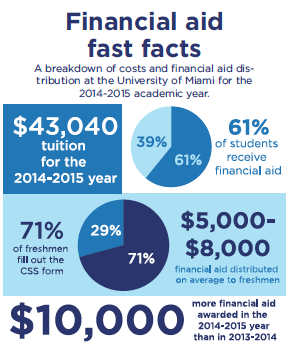The Office of Financial Aid is aiming to alleviate some of the costs of attending the University of Miami, the most expensive school in Florida.
Financial Aid is encouraging students to complete an additional document called the College Scholarship Service (CSS) Profile in addition to the Free Application for Federal Student Aid (FAFSA) form to increase the chances of receiving more money.
Since the campaign began, the office has distributed $10,000 more in aid during the 2014-2015 academic year compared to 2013-2014. Of the $400 million received from the federal government, UM still has $4 million to distribute as financial aid.
“I don’t want to go to the provost at the end of the year not having spent everything,” said Raymond Nault-Hix, associate dean of enrollment management. “We really are trying to make a difference in student’s lives.”
The CSS profile asks more in-depth questions about students’ financial situations than the FAFSA does, such as their family’s medical and dental bills, loss of income and if a sibling attends another college.
For example, if a student has a sibling in a community college, FAFSA will not take the cost difference into account. The government will give equal aid to both without acknowledging that UM costs more than the sibling’s school.
In an attempt to “ensure the resources are allocated appropriately,” Nault-Hix said that 1,600 students claimed they have siblings in college. After individual follow-ups, 300 students acknowledged they did not. As a result, Financial Aid was able to allocate those funds to others.
Financial Aid has been calling returning students to determine their eligibility for any need that has not been met. About 71 percent of first-year students in the class of 2018 filled out the CSS Profile and an average of $5,000 to $8,000 was distributed.
Freshman Joshua Beauplan, who completed the CSS Profile, was confused by all the questions but understood why the form was required.
“It took a while to fill it all out, but it did help my financial aid, even if it didn’t meet all my requirements,” he said.
Returning student Joseph Dunn had a different experience. He had a hard time completing not only the CSS Profile, but also the paperwork concerning his sister, who attends Miami-Dade College.
“I wasn’t told about the paperwork I had to turn in until a few days before it was due, and we had to argue for about an hour,” Dunn said.
Other schools, including New York University and Duke University, also use a similar allocation system to alleviate students’ financial burdens. Nault-Hix hopes to follow in their footsteps and one day become a no-loan program like the one at Harvard University.
“We are aiming to cover 100 percent of [students’] demonstrated need,” Nault-Hix said. “However, you have to help yourself– it’s a partnership.”
To help themselves, students must also be willing to contribute self-help through work-study jobs and loans.
Additionally, changes will be implemented to help eliminate students’ confusion regarding financial aid. A call center will be available for students to speak with student employees about general financial aid questions.
Also, rather than informing students in July or August, CaneLink will display available financial awards by mid-May and June.
Financial Aid plans to improve communication with Student Accounts, the office responsible for collecting tuition. The two offices’ staffs will receive a cross-training, even though it’s “more work for the staff,” Nault-Hix said.







